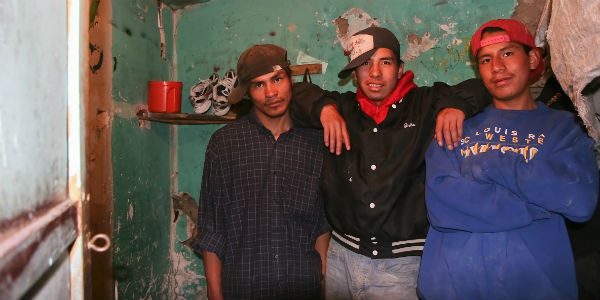When inmates make the rules (and enforce them): democracy in self-governing prisons
What happens when a state fails to run its prisons? David Skarbek and Courtney Michaluk examine the phenomenon of prison self-governance – when inmates are locked up but left to their own devices. In some jails in Latin America, prisoners establish their own governing bodies to keep order, sometimes even setting up extralegal courts of their own. Even in California, understaffing means that gangs determine much of everyday prison life.

Inmates at San Pedro prison in Bolivia, which is essentially self-governing. Photo: Danielle Pereira via a CC-BY-SA 2.0 licence
Popular stereotypes often portray prisons in one of two ways: either overcrowded, violent, and chaotic places, like those found in some parts of America, or small, peaceful, and well-organised, like those found in much of Scandinavia. It turns out that life behind bars actually differs in many ways. In some prisons, officials are the main source of order and security. In others, prisoners play a significant role in producing stability and governance within the society of captives. In fact, in some facilities, the prisoners participate in thriving associations based on democratic principles. Given that the basic structures of prisons are similar around the world, what explains the diversity of outcomes within prisons?
In a recent article, Covenants without the Sword? Comparing Prison Self-Governance Globally (American Political Science Review), these questions are addressed by developing a theory of prison governance, drawing on works by economists and political scientists. The evidence used to support this theory is then provided by surveying a wide-range of rich ethnographic studies of prison life conducted by scholars in anthropology, criminology, and sociology.
Where these apparently disparate fields meet is in their study of social control. We often assume that government is the key source of order in society. States often protect property rights and enforce agreements. Yet that’s not always the case. In many situations, states withhold or fail to provide effective governance. When that happens, extralegal governance mechanisms can dictate the rules of entire societies. The result is that some prisons are literally run more by the prisoners than by officials.
Some of the most striking examples of prisoner-run prisons comes from Latin America. Prisons in Brazil are severely overcrowded and understaffed. In a Rio de Janiero jail, only six prison officials oversaw more than 1,400 prisoners. In another case, five prison officers staffed a prison of more than 4,000 prisoners. In addition to lack of supervision, many of these facilities often lack food, clean water, and even mattresses for inmates.
In the absence of supplies and support from officials, prisoners form governing bodies—sometimes called gangs, but often not—to establish order. For example, a well-known Brazilian prison gang, the Primeiro Comando do Capital, created “inmates’ courts” to settle disputes. Their presence led to a fall in inmate violence, even with no official governing body to administer these courts. In a Bolivian prison, inmate-elected representatives and inmate trustees run the prison. Criminologist Sacha Darke documents one Brazilian jail where the trustees are responsible for cooking, cleaning, and providing basic amenities like bedding and toiletries to inmates.
Extralegal governance in prisons is often intricate and well organised. In Bolivia, San Pedro Prison holds around 1,500 prisoners in a facility designed to hold only 400. While guards monitor entry into the prison, the rest of the prison is essentially self-governed. In different housing sections within the prison, governance committees operate, collect taxes, make repairs, agree on rules, and resolve disputes. The prisoners elect their representatives and these committees operate the prison as though it is a small city. When officials fail to govern, prisoners do.
By contrast, these elaborate prisoner associations do not exist in prisons that provide substantial resources, competent administration, and effective governance. Nordic prisons are an obvious example. Prison officials are well-trained and viewed as doing an important job for society. Most Scandinavian prisons hold fewer than 100 people and there is no overcrowding. Prisons in Denmark, Sweden, and Norway have prisoner to staff ratios of nearly 1:1. In such an environment, prisoners have few reasons to invest in the types of elaborate structures found in Brazil and Bolivia. When officials govern effectively, prisoners do not.
The size of the prison population also affects the social order. Consider, for example, men’s prisons in England and California. They share many of the same criminal justice practices and philosophies, but the typical prison in California holds five times more prisoners than one in England & Wales—about 3,500 versus 700 prisoners per prison. This difference in size has two consequences. First, big prisons are more difficult for officials to monitor and control, so that means there is a more serious gap in governance for California prisoners than for English prisoners. Second, in large prison populations, prisoners cannot rely on informal mechanisms of social control, such as gossip and ostracism. It hurts to be an outcast in a small community, and that encourages conformance to accepted norms of behaviour. However, in big prisons, an ostracised prisoner can always find someone else to associate with.
The inability to rely on these informal mechanisms means that prisoners in California have turned to gangs to offer a more centralised source of extralegal governance. In California – but not England – prison gangs dominate the everyday life of prisoners. They decide who shares a cell, who uses the basketball court, who a prisoner can have a meal or cigarette with, and when prisoners must go to bed. More generally, the gangs operate their own legal system, providing an arena to resolve social and commercial disputes. This is especially important given that prisoners can’t rely on officials to regulate the flourishing underground economy.
These cases suggest that even though prisons share many of the same essential features – people are forced to enter, cannot leave, and live within a less trustworthy population – prison life can look and feel very different. When officials fail to govern, prisoners often revert to elaborate associations, consensus building and democratic procedures.
This post represents the views of the authors and not those of Democratic Audit.
 David Skarbek is a Senior Lecturer in Political Economy at King’s College London.
David Skarbek is a Senior Lecturer in Political Economy at King’s College London.
Courtney Michaluk is a policy analyst at the Manuel H. Johnson Center for Political Economy at Troy University.





 Democratic Audit's core funding is provided by the Joseph Rowntree Charitable Trust. Additional funding is provided by the London School of Economics.
Democratic Audit's core funding is provided by the Joseph Rowntree Charitable Trust. Additional funding is provided by the London School of Economics.